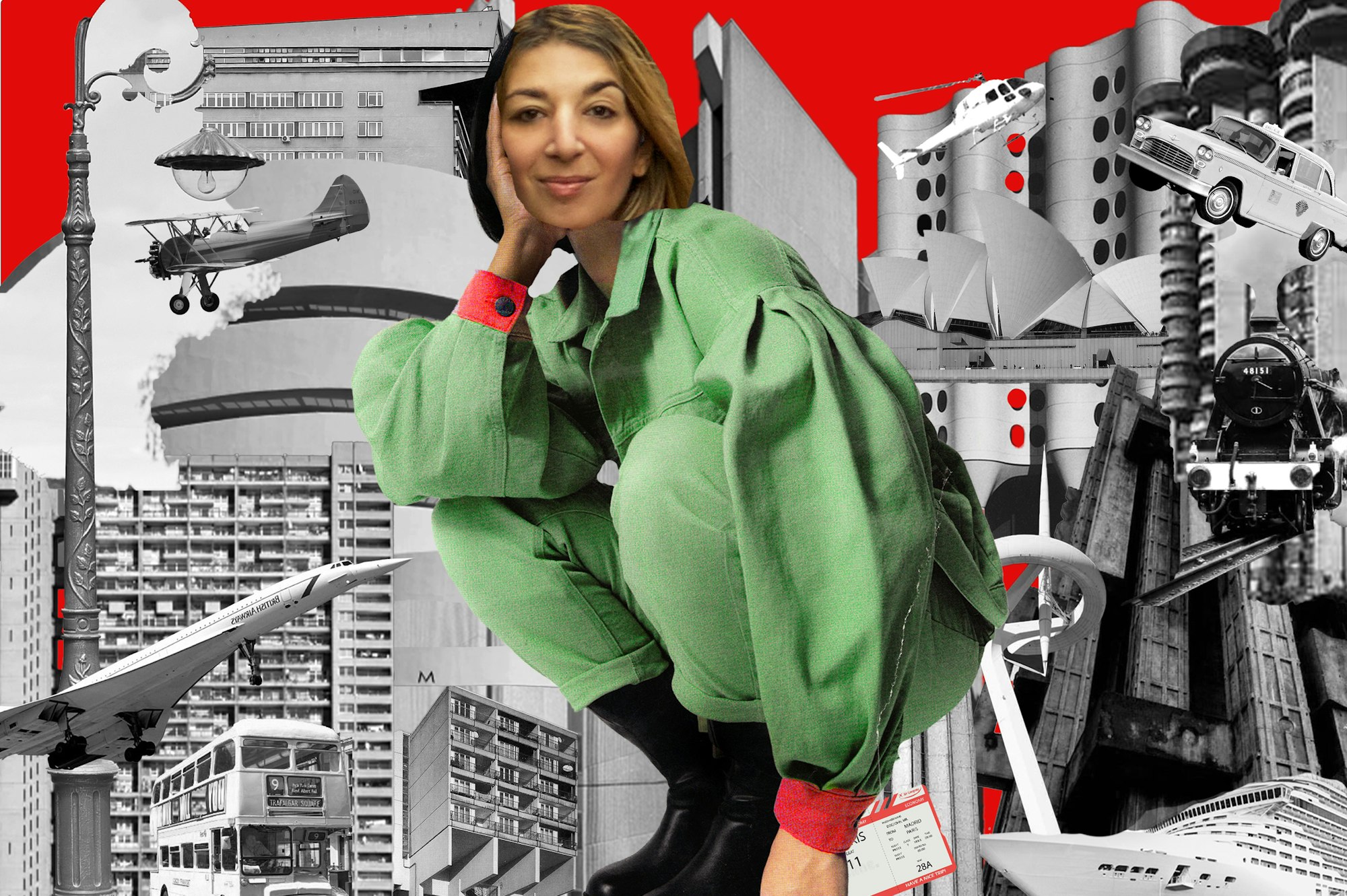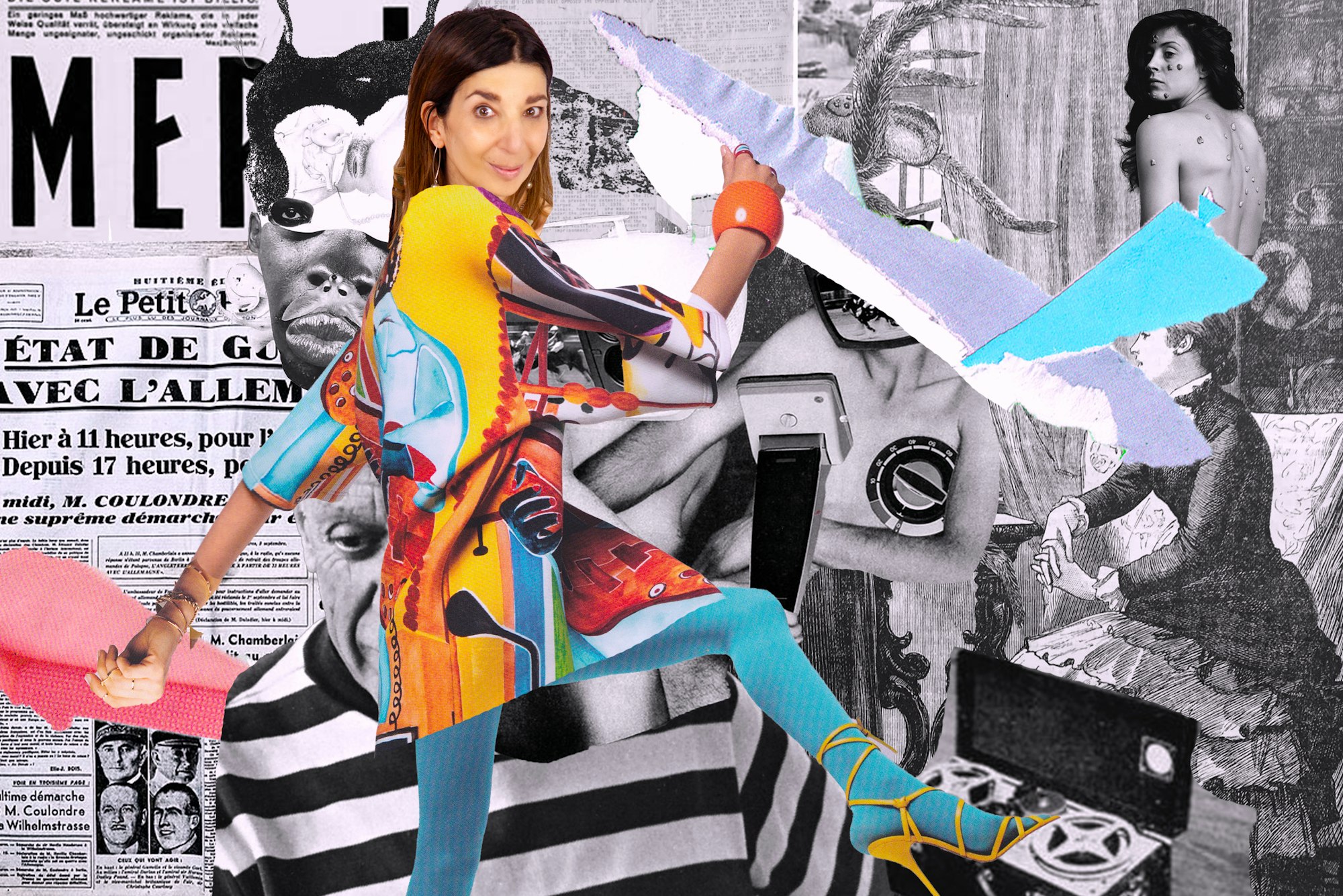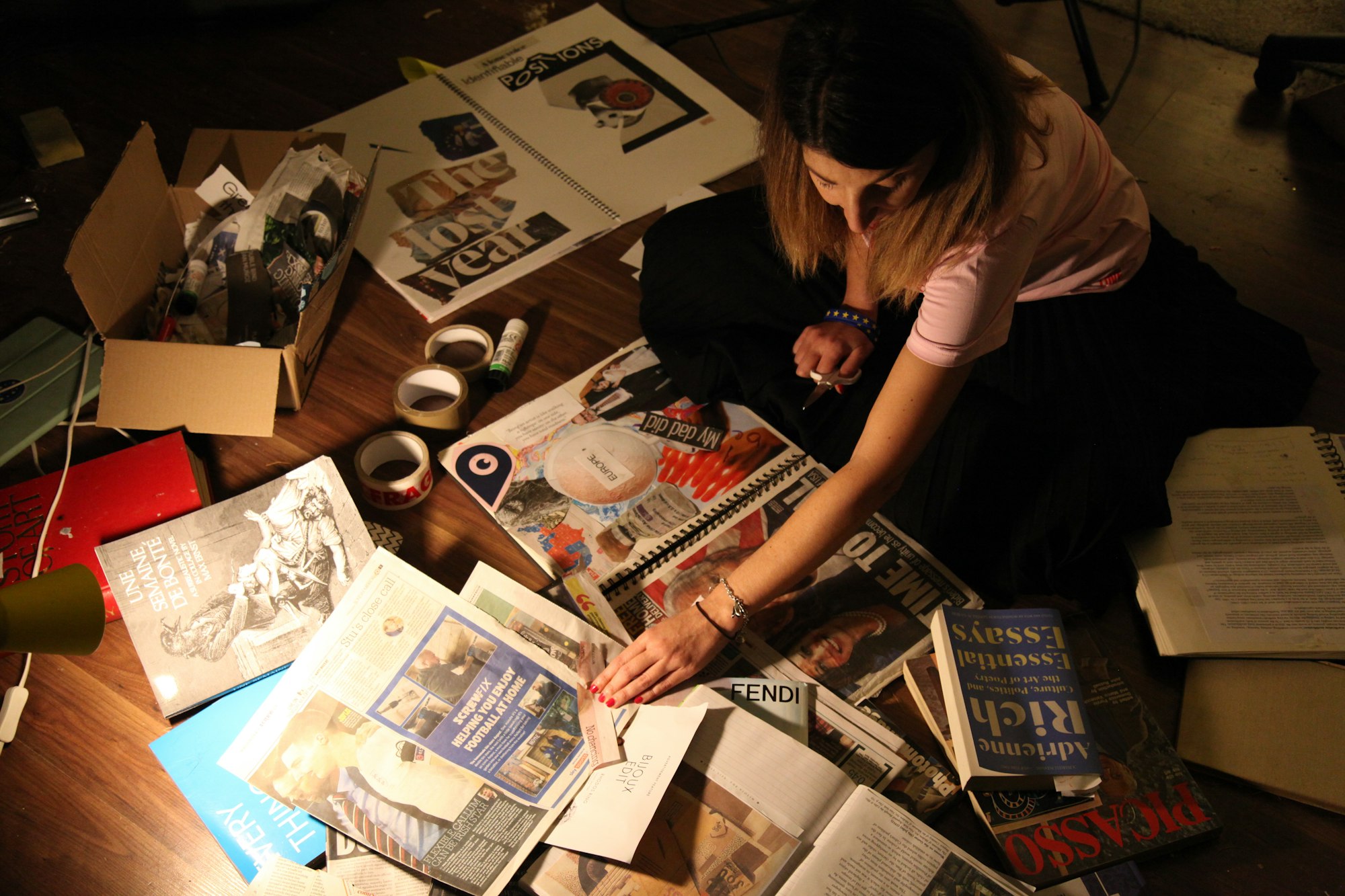Words by Anton Spice
Mira Calix was sitting in her studio surrounded by magazine offcuts, snippets of text and crime scene Post-Its when news came through that the US Capitol was under attack. She switched on the news and sat back, dumbfounded, as MAGA-clad rioters stormed the corridors of Congress. And then she hit record.
The CNN newsreel Calix captured on 6th January 2021 was one of the last sonic fragments to be stitched into the fabric of absent origin, an album made over eight of the most turbulent months in living memory. Against a backdrop of the COVID-19 pandemic, BLM movement, global feminist protests, the Brexshit debacle (her words!), the US election and subsequent insurrection, she pillaged her hard-drive “like a box of magazines”, cutting-and-pasting together a record that used the unfolding of history as its source material.
Although often considered primarily a visual art form, collage has a rich musical and textual history, from the Dadaists to musique concrète, hip-hop sampling to memes and mashups. It’s in this mutable borderland between medium and message that Calix feels most at home. Here, she is free to shape-shift, whether releasing electronic music on Warp, as she has done since the mid-’90s, composing for orchestras, or creating audio-visual installations for all manner of built environments.
In fact, it was a commission for Armistice Day at the Tower of London in 2018 that provided the initial spark for her interest in sonic geopolitics and the emerging parallels of our own fractured politics. “Everything had broken down and new things had to be made out of the fragments,” artist Kurt Schwitters observed in 1918. Then, as now, it was collage that could articulate the future.
Calix calls herself “a scissors person”, and will take a blade to field recordings, a provocative Tweet or a piece of physical newsprint without discrimination. The cover of a̶b̶s̶e̶n̶t̶ origin features 18 mini-Miras, each glued together to refer to a track on the album, and the visual collage artist whose work inspired it. “absent origin is a kind of living organism in the way that collage is,” she describes. “It is an installation, it is a performance, it is all the artwork, and all the things [that happened] are part of its narrative.” It’s also probably safe to say that this is the only album ever released on Warp - or at all - to feature a reference to the proroguing of Parliament.
I'm not so interested in standing on a stage and beaming out to you. I want to be in there with you.
But then, as Calix would say, we cannot choose our origins or the times in which we live, and for every clip of a Chilean protest anthem or a Mary Borden poem is a personal experience made greater than the sum of its parts. “The stories of collage artists are so affected by geopolitics,” she observes. Through the art of juxtaposition, these artists tear at the edges of society, transgress its boundaries and reimagine its conventions. It’s a radical tradition of which Calix is very much now a part.
Just days after Calix sent off the completed album, her hard drive collapsed, and all the residual traces of her work were swept away. What remains is a finished record of a moment in time, an album with its own absent origin that makes a case for solidarity in sound, dedicated to the citizens of nowhere.

There is so much at play here, I’d like to dive straight into the heart of the project. When you say collage artists were affected by geopolitics, do you mean that they were physically displaced as a consequence of geopolitical events, or that they were responding to these events in their work?
I think that displacement is a keyword. I'm thinking of people like Max Ernst, who was literally displaced and travelled on a false passport, as well as Hannah Höch, Raoul Hausmann and all these early collage artists. Then all the way through to Wangechi Mutu and her own restricted movements and work on the Mexico/U.S. border in Cutting. Whether it's the musical materials, which have all been displaced, or the more esoteric ideas, displacement is key. It ties up nicely with the title.
What does the title absent origin mean for you? And why did you decide to strike through the absent?
It was a very deliberate act. I’ve never known the title of an album before I wrote it, but I did know this title. I settled on it very quickly. The strike-through came much later, and it had this double meaning. It was a term used by academics or writers when they referred to the idea of collage. Again this works for sound collage, but you take a piece of material - a break or an image - and by moving it around and placing it with other things, it loses its original context and takes on a completely new meaning. The same goes for human beings. Origins affect all of life’s opportunities. And if you have an absence of origins, or in other words an absence of borders and nations, what will happen?
I'm playing with all those things, and I love the double face, the double meaning, of this term. Sometimes it's very overt in the album in what I’ve chosen to juxtapose, and sometimes it's more subtle.
I’m interested in participatory work. That doesn’t necessarily mean it’s interactive but more participatory in spirit.
In that sense, this feels like a highly political work that doesn't present itself explicitly as such.
I think because I was collaging, it is often hidden in the layers. In my head the first track, ‘A Mark of Resistance’, is a feminist anthem, but it's really all buried in the onion layers.
Let’s peel away some of those layers. What elements go into making up ‘A Mark of Resistance’?
It is a real mélange of old material, new material and lifting from the internet. We’ve talked about the fragments of my hard drive, but the percussion is actually me playing my body. I was also taking lots of sounds that were coming from social media. There are the Chilean protesters and the Las Tesis song ‘Un violador en tu camino’ [‘A rapist in your path’]. Then while I was writing it, the Strajk Kobiet [‘All-Poland Women’s Strike’] was happening in Poland and I was watching that unfold, and also taking bits from the Vagina Monologues [by Eve Ensler].
I also went back to older things off my hard drive. There is one clear sample - and I say that deliberately, because as far as I'm concerned the album only really makes one sample - and that's ‘Big Mama’ by Roxanne Shanté. She is like the godmother of hip-hop so it felt completely appropriate that she was in there. The quote 'her wounds come from the same source as her power' comes from the poet and feminist writer, Adrienne Rich. It's a very interesting phrase, and I think particularly for women it's so true.

Given that there are so many elements, how did you go about assembling the material for each track?
I had this big wall, a bit like a Scandi crime noir thing with lots of Post-It notes. I had chosen an artist for each track and each track had a lot of photo material and ideas thinking about what from my past might connect to this particular concept. It's really comparable to sitting there with scissors, glue and magazines, and thinking ‘I want something pink’. And then maybe you find something you didn’t know you were looking for and suddenly decide orange is going to be way better.
It sounds like you were thinking more visually than sonically at this point?
I was thinking very visually, but then that isn’t unusual, that’s how I approach music at all times. I think very structurally. I think of everything as building an environment. So for ‘A Mark of Resistance’ I was building a feminist environment, an environment that really considered the objectification of women and their role in society. But also I made something that you can dance to and is quite joyful I think at points.
The artwork definitely has a playfulness to it, as if you are performing in that environment yourself. How did you go about choosing the artists that inspired each track?
What I realised was that all my choices were not made randomly, they were made because something about that person’s work resonated with me. And sometimes it was something about their actual biography. So what I realised is that by looking at other people, actually what I was doing was looking back at myself. And in many ways, this is probably my most autobiographical album, but it has this veneer of looking out, which is what I thought I was doing.
It feels particularly autobiographical given that the source material is largely taken from your own archive of work.
Yes, exactly. Collaging myself. Within that are the voices of all these incredible musicians that I’ve worked with. I’d actually done a track like that years ago for London Sinfonietta called ‘Ort-Ord’ which basically means all the leftovers in your cupboard. If you want to know the source of this album, that is it. It was all the musical fragments from the ends of recordings, everything that was sitting on my hard drive that was going in the bin.
I think very structurally. I think of everything as building an environment.
It feels like quite a challenge to create a coherent whole from a process like this. Are there tracks that encapsulate what the album is about for you or do they work in communication with one another?
I think they do work in communication with one another. I remember when I did my first album I think the mastering engineer said, 'your gaps are amazing', and I laughed to myself because I had spent probably as much time on the gaps as I had on mixing some of the tracks.
When you say gaps, do you mean the pauses between songs?
Yeah, the spaces between tracks. I’ve done this with all my albums, and in the old days that was easy because an album was effectively a sealed unit. Now, because of how streaming works, it was a case of going to the mastering engineer and putting in these spaces, so that at the end of a track like 'Fractions Fractured Factions' there is a 0.5% dead space. It’s so that, I don’t know, a Jarvis Cocker track doesn’t kick in immediately! It's worth talking about. I have always really thought about these things. The spaces in between make it the whole.

What comes to mind again in a conceptual sense is borders. What is a gap between two tracks except a border? Either creating space for yourself or de-marking sonic territory.
Yeah, I think that's a really good analogy. I hadn’t thought about it, but you're the first person I've spoken to about the gaps! Silence is so important for music and we forget that. It creates juxtaposition.
Does this connect back to what you were saying about building environments?
I think being in music interests me far more than receiving music. I'm not so interested in being the broadcaster of music. I like to create the space in which the music exists and then you step into it. I find that so exciting. Even in my performance work, I'm not so interested in standing on a stage and beaming out to you. I want to be in there with you.
Your approach to absent origin does feel democratic and collective.
There is an ‘us’ in this album. I think it's like 'hear us now' as opposed to 'hear me now'. And even within the work, I'm crowdsourcing, literally grabbing crowds from the internet or working with previous collaborators, colleagues and strangers, and putting them in there. I’m interested in participatory work. That doesn’t necessarily mean it’s interactive but more participatory in spirit.
One of the fundamentals of assemblage as a concept is that each element gains meaning by being in relation to other elements, rather than because of its own innate properties.
You've nailed it. This is my articulation of all that thinking. It is my response to the world, to the practice and the methodology of collage, and to these individual people that I chose to investigate. They're part of the story and the making of the album, and the album exists in relation to all of them.
